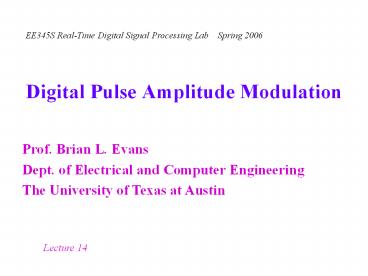Digital%20Pulse%20Amplitude%20Modulation - PowerPoint PPT Presentation
Title:
Digital%20Pulse%20Amplitude%20Modulation
Description:
Modulate M = 2J discrete messages or J bits of information into amplitude of signal ... Critical for receiver to sample at correct time instances to have max ... – PowerPoint PPT presentation
Number of Views:235
Avg rating:3.0/5.0
Title: Digital%20Pulse%20Amplitude%20Modulation
1
Digital Pulse Amplitude Modulation
2
Introduction
- Modulate M 2J discrete messages or J bits of
information into amplitude of signal - If amplitude mapping changes at symbol rate of
fsym, then bit rate is J fsym - Conventional mapping of discretemessages to M
uniformly space amplitudes - Pulse amplitude modulated (PAM) signal
fsym 1 / Tsym
No pulses overlap in timerequires infinite
bandwidth
3
Pulse Shaping
- Infinite bandwidth cannot be sent in practice
- Limit bandwidth by pulse shapingfilter with
impulse response gT(t) - L samples per symbol duration
- n is symbol index
- m is sample index in a symbol m 0, 1, 2,, L-1.
At each time t, k is indexed over number of
overlapping pulses
At indices n m, k is indexed over number of
overlapping pulses
4
Pulse Shaping Example
2-PAM with Raised Cosine Pulse Shaping
5
Pulse Shaping Block Diagram
- Upsampling by L denoted as L
- Outpus input sample followed by L-1 zeros
- Upsampling by converts symbol rate to sampling
rate - Pulse shaping (FIR) filter gTsymm
- Fills in zero values generated by upsampler
- Multiplies by zero most of time (L-1 out of every
L times)
6
Digital Interpolation Example
- Upsampling by 4 (denoted by 4)
- Output input sample followed by 3 zeros
- Four times the samples on output as input
- Increases sampling rate by factor of 4
- FIR filter performs interpolation
- Lowpass filter with stopband frequency wstopband
? p / 4 - For fsampling 176.4 kHz, w p / 4 corresponds
to 22.05 kHz
7
Pulse Shaping Filter Bank
- Simplify by avoiding multiplication by zero
- Split the long pulse shaping filter into L short
polyphase filters operating at symbol rate
ak
gTsymm
D/A
Transmit Filter
L
sampling rate
sampling rate
analog
analog
symbol rate
gTsym,0n
s(Ln)
D/A
Transmit Filter
gTsym,1n
s(Ln1)
ak
Filter Bank Implementation
gTsym,L-1n
s(Ln(L-1))
8
Pulse Shaping Filter Bank Example
- Pulse length 24 samples and L 4 samples/symbol
- Derivation in Tretter's manual,
- Define mth polyphase filter
- Four six-tap polyphase filters (next slide)
Six pulses contribute to each output sample
9
Pulse Shaping Filter Bank Example
24 samples in pulse
gTsym,0n
4 samples per symbol
Polyphase filter 0 response is the first sample
of the pulse shape plus every fourth sample after
that
x marks samples of polyphase filter
Polyphase filter 0 has only one non-zero sample.
10
Pulse Shaping Filter Bank Example
24 samples in pulse
gTsym,1n
4 samples per symbol
Polyphase filter 1 response is the second sample
of the pulse shape plus every fourth sample after
that
x marks samples of polyphase filter
11
Pulse Shaping Filter Bank Example
24 samples in pulse
gTsym,2n
4 samples per symbol
Polyphase filter 2 response is the third sample
of the pulse shape plus every fourth sample after
that
x marks samples of polyphase filter
12
Pulse Shaping Filter Bank Example
24 samples in pulse
gTsym,3n
4 samples per symbol
Polyphase filter 3 response is the fourth sample
of the pulse shape plus every fourth sample after
that
x marks samples of polyphase filter
13
Intersymbol Interference
- Eye diagram is empirical measure of quality of
received signal - Intersymbol interference (ISI)
- Raised cosine filter has zeroISI when correctly
sampled
14
Symbol Clock Recovery
Optional
- Transmitter and receiver normally have different
crystal oscillators - Critical for receiver to sample at correct time
instances to have max signal power and min ISI - Receiver should try to synchronize with
transmitter clock (symbol frequency and phase) - First extract clock information from received
signal - Then either adjust analog-to-digital converter or
interpolate - Next slides develop adjustment to A/D converter
- Also, see Handout M in the reader
15
Symbol Clock Recovery
Optional
- g1(t) is impulse response of LTI composite
channel of pulse shaper, noise-free channel,
receive filter
s(t) is transmitted signal
g1(t) is deterministic
Eak am a2 dk-m
Periodic with period Tsym
16
Symbol Clock Recovery
Optional
- Fourier series representation of E p(t)
- In terms of g1(t) and using Parsevals relation
- Fourier series representation of E z(t)
where
17
Symbol Clock Recovery
Optional
- With G1(w) X(w) B(w)
- Choose B(w) to pass ? ½wsym ? pk 0 except k
-1, 0, 1 - Choose H(w) to pass ?wsym ? Zk 0 except k
-1, 1 - B(w) is lowpass filter with wpassband ½wsym
- H(w) is bandpass filter with center frequency wsym































